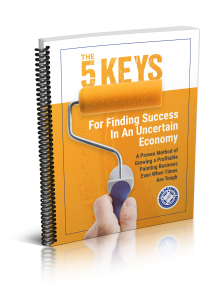Creating a Powerful Portfolio for Your Painting Business Sales Calls
If you’re losing painting projects to cheap, unprofessional competitors this might be the reason. It amazes me after years of doing this that people are still using the email, a PDF, pet the dog sales process. Basically just getting people a number as quickly as possible, and hoping that they buy from you without taking much time to be persuasive or to demonstrate the difference between your company and other competitors. And while I can spend four to eight hours training you on what we call the power paint presentation process, I’m going to hone in today on creating a portfolio for your painting business. Most people think about the word portfolio, they simply think of pictures of completed projects. It’s sad that most painting contractors don’t even show their clients that, but there’s a little bit of nuance to it.
Know What Your Clients Care About
The first thing is that you have to really know what your clients care about. It usually has nothing to do with overly technical matters of expertise and product selection, although it can to a degree. It rarely has anything to do with the type of paint or products you use. It has more to do with their personal safety, assurances that you can give them that the work will hold up and what their client experience will be like. And so, in order to do that, you have to really think like the client and not as a painting contractor. What is it they really want to see and know before they can do business with me?
Show Them The Evidence
Number two is putting together that proof, that evidence, that third party representation of that messaging into a portfolio. That can be before and after pictures, it can be pictures of clients with smiling, happy contractors. It can be background checks, certificates, warranties, guarantees, tons of reviews, and social proof, and mixed mediums. That’s really what I’m talking about when I talk about a portfolio. It’s not just pictures of completed work. The third thing you have to ask yourself is how am I going to assemble and use this portfolio? So the first thing is, what do they care about, the second thing is, do I have the evidence and the proof in here that’s sufficient. And then the third thing is, how will I put this portfolio together?
Putting It All Together
Well, in our process, we teach people to send a lot of information and pre-positioning. We teach them how to walk through a company story. We teach them how to use a post positioning/buyer’s guide and even a leave-behind book when they go out to the car to create an estimate. Takes the same amount of time as your typical sales call, and just allows you to close at higher rates and higher prices, because they compare your sales process with unprofessional, lazy competitors. Now, you can put that portfolio together in an abbreviated fashion where you just hit the highlights. You can put a huge, long mountain of proof leave behind book in analog form, three-ring binder. You can put it on an iPad and flip through it as if it were a sales presentation. So there are multiple ways to do it. You can abbreviate it, you can elongate it, you can do it digitally, you can do it in an analog format. And the secret to all of that is using the right version of your portfolio at the right time in the sales process, and often you’re going to use the same information or similar information over and over again in shorter and longer forms and in digital and analog mediums. That may seem repetitive to show that type of information to people before, during, and after the sale in multiple formats, but the truth is your clients are deaf, dumb, and blind to what you’re trying to communicate.
Don’t Stop Building
And in order for them to believe you, in order for them to understand the difference, they often have to see that portfolio a few different times in a few different ways in varying lengths. So, put your portfolio together, start with something simple, and then make it bigger, and then put it throughout your sales process. I’m Brandon Lewis with Painters Academy and Painters Weekly. Go out there and close some jobs. And if I can ever help you, email brandon@paintersacademy.com, I’d be happy to set up a consultation so we can dig into the business systems and see if we can help you make more money with less stress in the same amount of time.
The 5 Keys for Success in ANY Economy

Discover the key to unlocking the hidden income potential in your painting business.
Hear What Other Members are Saying:

Jim and Lorraine
“Our first campaign reached $60,041.98! That's a huge percentage of our annual sales! You don't pick the peach orchard just one time. Different peaches ripen every day. Thanks for encouraging us to keep after it!”

Eric
“15 requests for quotes and closed and/or completed $23,000 of work and I still have a few more to do. Conservatively this campaign will net $25,000 in found money in the first 45 days! Thanks Brandon!”

Torlando
“This year has been the biggest year of growth for us. We're double where we were last year. I realized the real money in this business is in the marketing of the services - not the doing of the services.”
The 5 Keys for Success in ANY Economy
Discover the key to unlocking the hidden income potential in your painting business.
